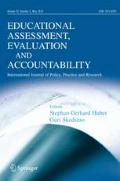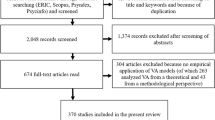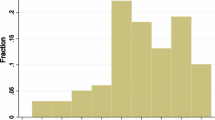Abstract
The Tennessee Value-Added Assessment System (TVAAS) has been designed to use statistical mixed-model methodologies to conduct multivariate, longitudinal analyses of student achievement to make estimates of school, class size, teacher, and other effects. This study examined the relative magnitude of teacher effects on student achievement while simultaneously considering the influences of intraclassroom heterogeneity, student achievement level, and class size on academic growth. The results show that teacher effects are dominant factors affecting student academic gain and that the classroom context variables of heterogeneity among students and class sizes have relatively little influence on academic gain. Thus, a major conclusion is that teachers make a difference. Implications of the findings for teacher evaluation and future research are discussed.
Similar content being viewed by others
References
Berk, R. (1988). Fifty reasons why student achievement gains does not mean teacher effectiveness. Journal of Personnel Evaluation in Education, 1(4) 345–364.
Brophy, J. (1968). Teacher influences on student achievement. American Psychologist (October), 1069–1077.
CTB/McGraw-Hill (1990). Comprehensive test of basic skills (4th ed.). Spring Norms Book. Monterey, CA: CTB/Macmillan/McGraw-Hill.
Ellett, C. D. (1990). A new generation of classroom-based assessments of teaching and learning: Concepts, issues and controversies from pilots of the Louisiana STAR. Baton Rouge: Teaching Internship and Statewide Teacher Evaluation Projects, College of Education, Louisiana State University.
Kulik, J. A. (1992). An analysis of the research on ability grouping: Historical and contemporary perspectives. National Research Center on the Gifted and Talented. Storrs, CT: University of Connecticut.
O'Neil, J. (1992). On tracking and individual differences: A conversation with Jeannie Oakes. Educational Leadership, 50(2), 18–21.
Peterson, D., Kromrey, J., & Smith, D. C. (1990). Research-based teacher evaluation: A response to Scriven. Journal of Personnel Evaluation in Education, 4(1), 7–18.
Porter, A. C., & Brophy, J. (1988). Synthesis of research on good teaching: Insights from the work of the Institute for Research on Teaching. Educational Leadership, 45(8), (May), 74–85.
Rogers, K. B., & Kimpston, R. D. (1992). Acceleration: What we do vs. what we know. Educational Leadership, 50(2), 58–61.
Rosenthal, R. (2984). Meta-analytic procedures for social research. Beverly Hills, CA: Sage.
Sanders, W. L., & Horn, S. P. (1995a). Educational assessment reassessed: The usefulness of standardized and alternative measures of student achievement as indicators for the assessment of educational outcomes. Educational Policy Analysis Archives, 3(6).
Sanders, W. L., & Horn, S. P. (1995b). The Tennessee Value-Added Assessment System (TVAAS): Mixed model methodology in educational assessment. In A. J. Shinkfield & D. Stufflebeam (Eds.), Teacher evaluation: Guide to effective practice (pp. 337–350). Boston: Kluwer.
Sanders, W. L., & Rivers, J. C. (1996). Cumulative and residual effects of teachers on future student academic achievement. Research Progress Report. Knoxville: University of Tennessee Value-Added Research and Assessment Center.
Sanders, W. L., Saxton, A. M., & Horn, S. P. (In press). The Tennessee Value-Added Assessment Systems (TVAAS): A quantitative, outcome-based approach to educational assessment. In J. Millman (Ed.), Assuring accountability? Using gains in student learning to evaluate teachers and schools. Thousand Oaks, CA: Corwin Press.
Schalock, H. A., & Schalock, M. D. (1993). Student learning in teacher evaluation and school improvement: An introduction. Journal of Personnel Evaluation in Education, 7(2), 103–104.
Scriven, M. (1990). Can research-based teacher evaluation be saved? Journal of Personnel Evaluation in Education, 4(1), 19–39.
Slavin, R. E. (1987). Ability grouping and student achievement in elementary schools: A best-evidence synthesis. Review of Educational Research, 57(3), 293–336.
Slavin, R. E. (1990). Achievement effects of ability grouping in secondary schools: A best-evidence synthesis. Review of Educational Research, 60(3), 471–499.
Travers, R. M. W. (1981). Criteria of good teaching. In J. Millman (Ed.), Handbook of teacher evaluation (pp. 14–22). Beverly Hills, CA: Sage.
Wang, M. C., Haertel, G., & Walberg, H. J. (1993). Toward a knowledge base of school learning. Review of Educational Research, 73(3), 249–294.
Author information
Authors and Affiliations
Rights and permissions
About this article
Cite this article
Sanders, W.L., Wright, S.P. & Horn, S.P. Teacher and Classroom Context Effects on Student Achievement: Implications for Teacher Evaluation. Journal of Personnel Evaluation in Education 11, 57–67 (1997). https://doi.org/10.1023/A:1007999204543
Issue Date:
DOI: https://doi.org/10.1023/A:1007999204543




